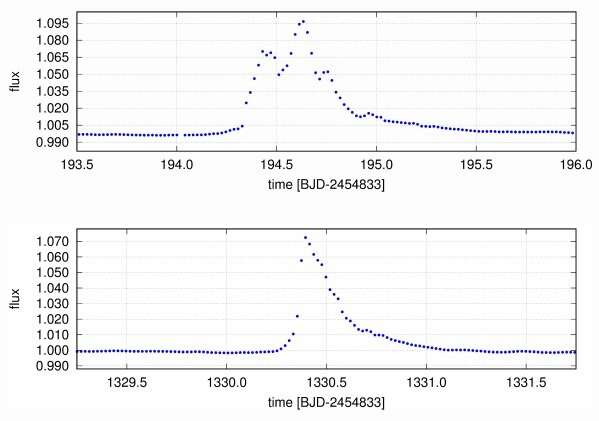May 19, 2020 report
Astronomers study flaring activity of the giant star KIC 2852961

Using data from NASA's TESS and Kepler spacecraft, as well as from the Konkoly Observatory, astronomers have inspected flares and superflares of a late-type giant star known as KIC 2852961. Results of the study, presented in a paper published May 11 on arXiv.org, could help astronomers to better understand the mechanism behind flaring events in giant stars.
Stellar flares are energetic and impulsive releases of large amounts of energy from a star. They occur when a shift in the star's magnetic field accelerates electrons to speeds approaching that of light, which results in eruptions, producing emission across the entire electromagnetic spectrum.
Located about 2,650 light years away, KIC 2852961 (other designations: 2MASS J19261136+3803107, TIC 137220334) is about 13 times larger than our sun. It has an effective temperature of around 4,722 K, and rotation period of approximately 35.5 days.
Previous observations of KIC 2852961 have detected large flares from this source and determined that its spectral type is most likely G9 or K0 III. One study suggested that the object as a single-lined spectroscopic binary, however not offering any details about its properties.
Now, a team of astronomers led by Zsolt Kővári of the Konkoly Observatory, Hungary, decided to take a closer look at the flares taking place on KIC 2852961, in order get more insights into the nature of this object. For this purpose, they have analyzed the data obtained with the Transiting Exoplanet Survey Satellite (TESS) and Kepler spacecraft, and also conducted new observations of KIC 2852961 using Konkoly Observatory's 1-m RCC telescope.
"In this paper, the flare activity of the late G-early K giant KIC 2852961 were analyzed using the full Kepler data (Q0-Q17) and one TESS light curve (Sector 14 from July-August 2019) in order to study the flare occurrence and other signs of magnetic activity," the astronomers wrote.
As a result, the researchers identified 59 flaring events on KIC 2852961 with logarithmic flare energies between 35.74 and 38.38 erg. This means that the flares on KIC 2852961 are in general more powerful than the flares observed on other giant stars investigated with Kepler.
The study found that KIC 2852961 has a mass of around 1.7 solar masses, while some studies pointed out to a nearly 50% lower mass of this object. This result suggests a faster evolution or younger age (about 1.7 billion years) for KIC 2852961 than previously thought.
The astronomers also derived a cumulative flare frequency distribution diagram, which turned out to deviate from a simple power law. This deviation is puzzling and needs further investigation.
"Flare counts and total flare energies per unit time show temporal variations related to the average light curve amplitude. A straightforward interpretation is that the higher the level of spot activity the more the overall magnetic energy released by flares and/or superflares," the researchers explained.
More information: Superflares on the late-type giant KIC 2852961, arXiv:2005.05397 [astro-ph.SR] arxiv.org/abs/2005.05397
© 2020 Science X Network




















